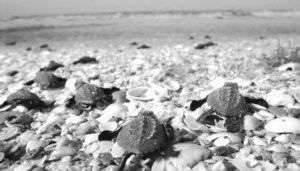 |
 |
 |
 Editorials | Environmental | September 2007 Editorials | Environmental | September 2007  
Endangered Turtles Nesting on Texas Coast in Record Numbers
 Bill Hanna - Star-Telegram Bill Hanna - Star-Telegram
go to original


| | Baby Kemp's ridley turtles make their way to the Gulf of Mexico on the evening of June 28, 2006, at a camp on the beach at Tepehuajes, Mexico. (Star-Telegram/Rodger Mallison) |
Twenty years ago, they were on the verge of extinction.

But the Kemp's ridley sea turtle, still the world's most endangered sea turtle, appears to be on its way back.

This year, 128 nests were found on the Texas coast, breaking last year's record of 102.

On the Mexican Gulf Coast, which is the turtle's historical home, more than 13,000 nests have been found; there were 12,700 last year.

"We're not there yet, but it's encouraging, much more encouraging than where we were a few years ago when there was a real question of whether the turtles were going to make it," said Donna Shaver, a research biologist for the U.S. Geological Survey at the Padre Island Field Research Station.

Jaime Peña, curator of conservation programs at Brownsville's Gladys Porter Zoo, which oversees the Mexican Kemp's ridley program, agrees.

"The project seems to be working; the numbers speak for themselves," Peña said. "We're confident they will eventually be downlisted."

The background

In 1947, 40,000 Kemp's ridley turtles nested on a single day at Rancho Nuevo, Mexico, about 150 miles south of Brownsville. By 1985, when only 702 nests were found, scientists thought the turtle was doomed.

Eggs were brought to Padre Island National Seashore in 1978 to establish a second nesting site. In 1996, the first turtles returned, but only six nests were found.

As recently as 2001, only eight were found.

Long odds

Researchers say fewer than 10 in 10,000 Kemp's ridley hatchlings reach maturity. They also say the numbers won't keep increasing.

"You can never predict with turtles," Peña said. "They're always surprising you."

Smallest sea turtle

The Kemp's ridley is the smallest sea turtle. Roughly 60 percent of all its U.S. nestings occur on Padre Island.

"When you come out to the Texas coast, you need to keep your eyes open for nests and please immediately report any nests that you find, because they can be found just about anywhere on the Texas coast," Shaver said.

Often, the turtles lay eggs in massive groups called arribada.

You can never predict with turtles. They're always surprising you.

Online: www.nps.gov/pais/naturescience/stsr.htm

By the numbers

Kemp's ridley sea turtle eggs were first brought to Padre Island National Seashore in 1978. The number of nests in Texas has fluctuated but has generally increased since the turtles first returned to the seashore in 1996:

1996: six nests
1997: nine
1998: 13
1999: 16
2000: 12
2001: eight
2002: 38
2003: 19
2004: 42
2005: 50
2006: 102
2007: 128
Source: Padre Island National Seashore

Bill Hanna, 817-390-7698 billhanna@star-telegram.com | 
 | |
 |



